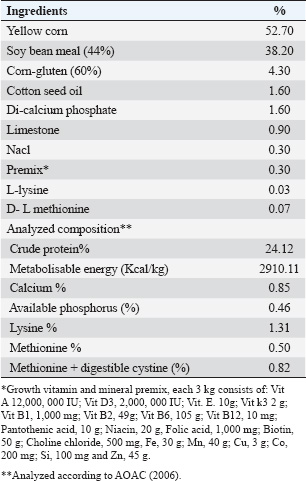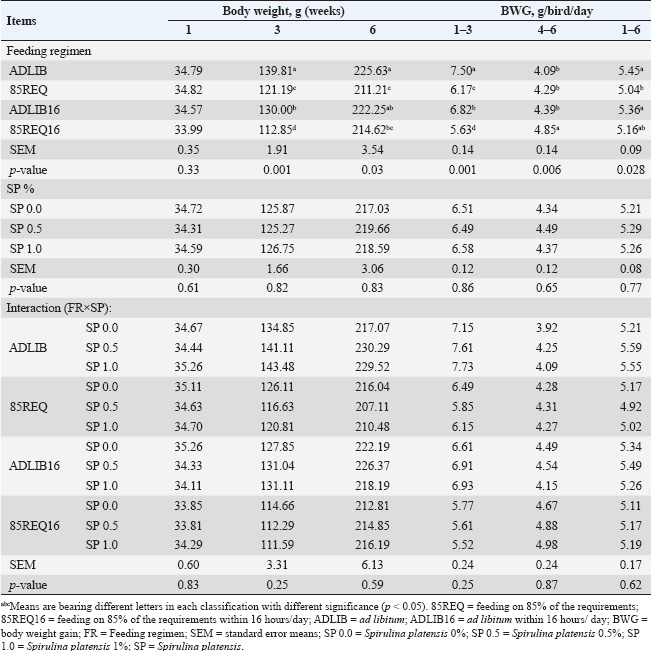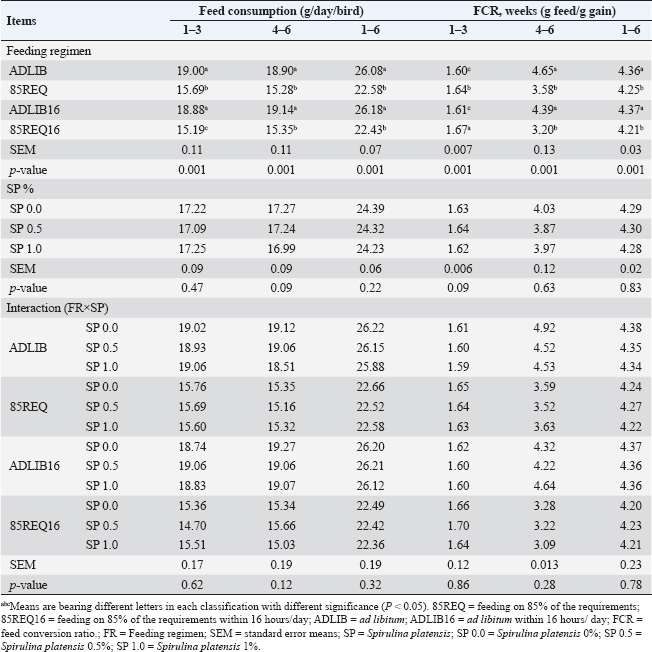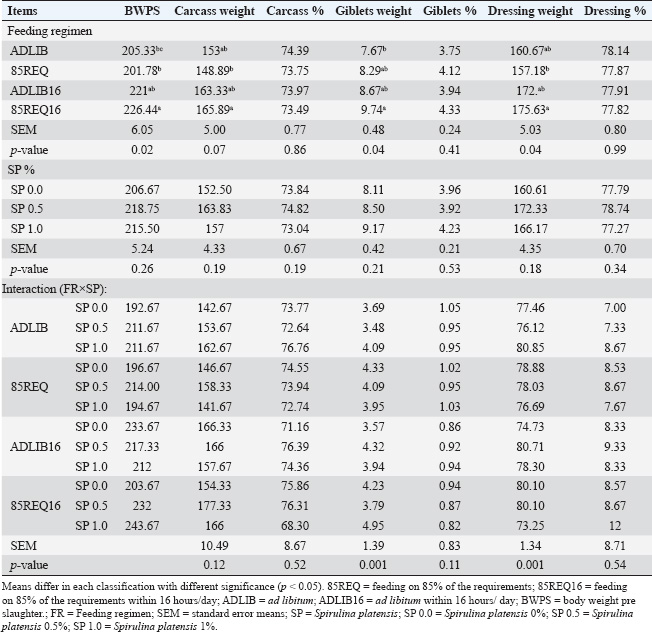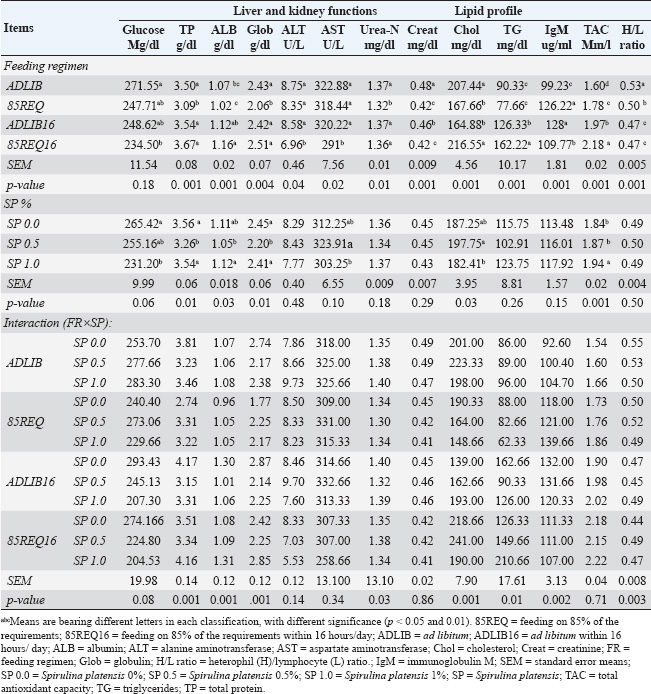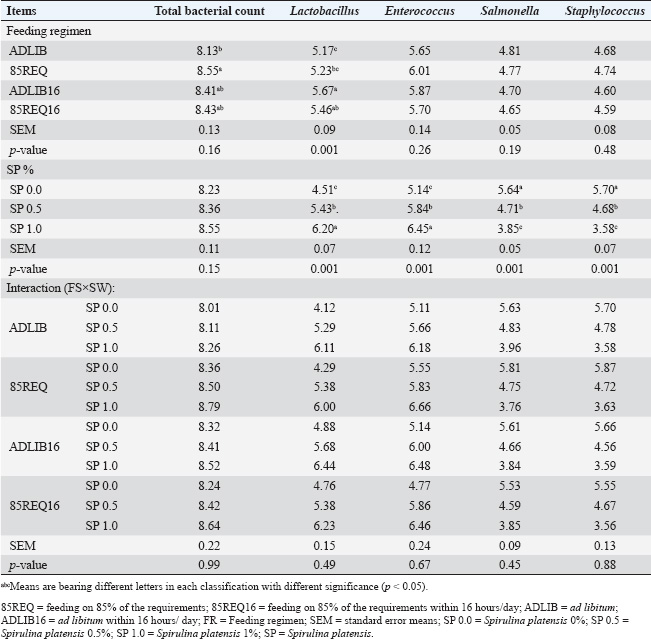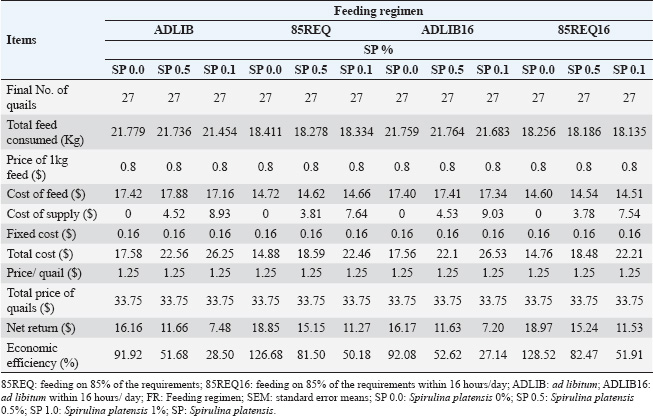
| Research Article | ||
Open Vet. J.. 2025; 15(8): 3514-3526 Open Veterinary Journal, (2025), Vol. 15(8): 3514-3526 Research Article Effects of feeding regimen and dietary supplementation with Spirulina platensis on growth performance, blood biochemistry, and microbial capacity in the digestive tract of Japanese quails (Coturnix Japonica)Samera Saeed, Mostafa Tawfeek, Diaa Abou-Kassem and Khalid Mahrose*Animal and Poultry Production Department, Faculty of Technology and Development, Zagazig University, Zagazig, Egypt *Corresponding Author: Khalid Mahrose. Animal and Poultry Production Department, Faculty of Technology and Development, Zagazig University, Zagazig, Egypt. Email: ostrichkhalid [at] zu.edu.eg Submitted: 01/06/2025 Revised: 04/07/2025 Accepted: 07/07/2025 Published: 31/08/2025 © 2025 Open Veterinary Journal
ABSTRACTBackground: Quail (Coturnix coturnix Japonica) is becoming an increasingly important source of meat and eggs worldwide. Some management and environmental issues are restraining the enhancement of quail farming. Aim: This study examined the growth performance of Japanese quail as influenced by feeding regimens and dietary supplementation with Spirulina platensis (SP). Methods: A total of 324 Japanese quail chicks [1-week old; initial body weight (BW): 34.5 g] were haphazardly divided into 12 groups (27 birds/group), with each group had three replicates (nine chicks/each), involving four feeding regimens [ad libitum (ADLIB), feeding on 85% of the requirements (85REQ), ADLIB within 16 hours/day (ADLIB16), 85REQ within 16 hours/day (85REQ16)], and three levels of dietary SP (0%, 0.5%, and 1%). Results: BW at marketing and BW gain at different ages were influenced by the feeding regimen. Birds that consumed 85REQ16 showed the lowest feed consumption (FC) at 1–3 weeks of age. During 4–6 and 1–6 weeks of age, quails fed on 85REQ and those fed on 85REQ16 consumed less feed. Quails of 85REQ16 exhibited the highest carcass, dressing, and giblet weights. Dressing and giblet weight differed due to the interaction between feeding regimen and dietary SP. Blood biochemicals were impacted by the feeding regimen, except for glucose concentration. Total protein, albumin, and globulin levels were low in 85REQ-fed quails. Quails fed a 1% SP-supplemented diet showed the lowest level of cholesterol and the greatest level of total antioxidant capacity. Most of the blood biochemicals studied fluctuated because of the interaction between the feeding regimen and dietary SP. The Lactobacillus count was the highest among the treatments as affected by the feeding regimen. Lactobacillus and Enterococcus counts increased with increasing dietary SP, whereas the reverse was observed in Salmonella and Staphylococcus counts. Birds fed SP0.0 with 85REQ16 and those fed SP0.0 with 85REQ had the highest (128.52 and 126.68%; respectively). Conclusion: In conclusion, quail could be kept under a feed regimen of 85REQ16, with dietary supplementation of SP for healthier growth performance. Keywords: Feed restriction, Growth, Microbial count, Japanese quail, Spirulina platensis. IntroductionQuail (Coturnix coturnix Japonica) has numerous advantages as a supplier of meat and eggs for human consumption in different countries (Farghly et al., and 2022; Mahrose et al., 2022). The quail agribusiness is increasing in attractiveness because quails are simple to handle and small; therefore, they can be reared in a small ground area (Attia et al., 2012; Abd El-Ghany, 2019). (Abd El-Ghany, 2019; Mahrose et al., 2019a, 2019b; Mahrose et al., 2021). Birds must be kept under ideal environmental circumstances to attain complete genetic growth ability, and any variation may damage their performance, produce immunosuppression, and alter their physiological reactions, increasing their susceptibility to diseases (Abd El-Ghany, 2019; Mahrose et al., 2021). The principle of feed restriction regimens in poultry breeds chiefly proposes reducing extra energy spending, which commonly occurs when feeding is supplied ad libitum (ADLIB) (Hertamawati et al., 2019; Mahrose et al., 2022). Quantitative and qualitative feed restriction can be employed to impact the feeding strategies of poultry species to reduce metabolic ratio and growth performance to some limit (Grieser et al., 2017; Dixon et al., 2022). Feed restriction regimens in growing poultry species are important for respectable performance in expressions of growth rate and feed conversion ratio (FCR) (Mahrose et al., 2022). Soomro et al. (2019) concluded that growing quail might be kept under a quantitative feed restriction regimen for 4–8 hours daily, along with dietary probiotic supplementation as a growth sponsor for improved growth. Seaweeds have been used in poultry to improve the immune condition of poultry, to reduce microbial capacity in the digestive tract, and to improve the quality of poultry eggs (Wang et al., 2013; Michalak and Mahrose, 2020). Spirulina platensis (SP) is a natural dietary supplement that is a valuable source of high-quality protein, vitamins, minerals, essential fatty acids, essential amino acids, carotenoids, and phenolic acids (Park et al., 2018; Ekizoglu et al., 2020; Michalak and Mahrose, 2020; Tufarelli et al., 2021; Mahrose and Michalak, 2022; Ismail et al., 2023). Various studies have indicated that SP augments growth performance because of its antioxidant, immunomodulatory, anti-inflammatory, antiviral, and antimicrobial activities in various animals (Michalak and Mahrose, 2020; Hassan et al., 2021; Ismail et al., 2023). From a profitable approach, dietary addition with 0.25% SP is suggested for Fayoumi broilers instead of 0.5% or 0.1% (Hassan et al., 2022). Feed restriction regimens for an extended interval could cause significant stress on poultry species. Seaweeds have been reported to alleviate stress and augment the bird’s immunity (Mahrose and Michalak, 2022). We theorized that SP addition would preserve the valuable bacterial population and clarify growth performance in this study. Consequently, the current study was designed to explore the impact of different feed restriction regimens, with or without dietary SP supplementation on growth performance, feed utilization, carcass biochemicals, and microbial capacity in the digestive tract of Japanese quails (Coturnix coturnix Japonica). Materials and MethodsBirds and their experimental designThis study was executed at the Animal and Poultry Production Department, Faculty of Technology and Development, Zagazig University, Zagazig, Egypt. At 1 week of age, 324 Japanese quail chicks [initial body weight (BW): 34.5 g] were haphazardly divided into 12 treatment groups (27 birds/ group), and each group had three replicates (nine chicks each). Each replicate was retained in one pen (35×50×50 cm). A 4×3 factorial arrangement was applied involving four feeding regimens ADLIB, feeding on 85% of the requirements (85REQ), ADLIB within 16 hours/day (ADLIB16), and 85REQ within 16 hours/day (85REQ16) and three levels of dietary SP supplementation (0.0%, 0.5%, and 1.0%). The nutritional levels of SP in the current investigation were implemented as suggested by Park et al. (2018) and Hassan et al. (2022). Preparation of SPThree strains of SP were obtained from the Agricultural Microbiology Department, National Research Center, Giza, Egypt: isolate strain NRC1, isolated from Manzala Lake in northeastern Egypt; isolate strain NRC2, isolated from Burulus Lake in northern Egypt; and genetically identified strain NRC3, isolated from Wadi El-Natrun in northwestern Egypt (Hoballah et al., 2012). The selected cyanobacterium SP from the National Research Center (NRC, Cairo, Egypt) was commercially grown for 25 days by the company El-Nabarawy (El-Farafra Oasis, Al-Wadi Al-Jadid governorate) that has raceway ponds (2 m width × 20 m length × 0.6 m depth) with paddle wheel as a stirring system with a speed of 40 rpm, an algal separating unit (GEA Westfalia centrifugal Separator: GEA Mechanical Equipment Canada, Inc.), and finally an algal drying unit that was local hot air (60°C) shelved drying pox. A modified medium containing commercial-grade chemicals was used to grow the alga under study (Hoballah et al., 2012; Arumugam et al., 2013). The culture medium of BG-11 was modified by the addition of 2.0 g l−1 NaHCO3 was selected and prepared for the growing cyanobacterium SP without adding citric acid as a carbon source and some elements that replaced by commercial grade chemical of super phosphate (1.25 g l−1), Urea 46.5%N (32.1 mg l−1) was added instead of sodium nitrate as nitrogen and carbon sources, potassium chloride (0.98 g l−1), sodium chloride (0.5 g l−1), magnesium sulfate (0.15 g l−1), calcium chloride (0.04 g l−1), and sodium bicarbonate (5 g l−1). Diet and its managementThe basal experimental diet was planned to include the nutrient requirements of growing Japanese quails as suggested by NRC (1994) through 1–6 weeks of age, as shown in Table 1. The quail chicks were kept under the same managerial, hygienic, and environmental conditions during the experimental period. Birds were subjected to 24 hours of light per day during the first week of the experiment. Then, chicks were provided with 16 hours of light/day during the experimental period. Throughout the experimental period, fresh water was accessible, and drinkers and feeding troughs were cleaned daily. A temperature of 34°C was supported through the first 3 days and was reduced to 33°C for 4 days, after which it was reduced 3°C/week until a stable temperature of 24°C was realized. MeasurementsBW and FC on a repeat of foundation were weighed to the closest gram at 1, 3, and 6 weeks of age, and then the mean BW gain and FCR (FCR; g feed/g gain) were processed throughout 1–3, 4–6, and 1–6 weeks of age. Dead quails were recognizable daily from 1 to 6 weeks of age. At 6 weeks of age, 72 males were randomly chosen (6 birds/ group; 2 birds/replicate) and randomly selected, having average BW about the quail group mean, fasted overnight, weighed, and slaughtered. The abdominal cavity was opened, and the edible organs (gizzard, liver, and heart) were removed and weighed in grams to the nearest three decimal points, proportionate to the live BW. The whole eviscerated carcasses were individually weighed, and the dressing percentage or carcass yield was recorded. Table 1. Composition and analysis of the experimental diet.
Biochemicals in blood plasmaBlood samples were collected at 6 weeks of age during slaughter to measure blood biochemicals. Plasma total protein, albumin, glucose, creatinine, urea-N, triglycerides (TGs), and cholesterol were measured colorimetrically using commercial kits (bought from Bio-diagnostic, Giza, Egypt) according to the manufacturer’s instructions. Plasma transaminase enzymes [alanine transaminase (ALT) and aspartate transaminase (AST)] activities were determined by colorimetric methods according to Diamond Bio-diagnostic, Giza, Egypt. Total protein, albumin, ALT and AST, and immunuglobulin M (IgM; ug/ml) values were assessed using biodiagnostic commercial kits [Biodiagnostic Company (Giza, Egypt) (Batch No: ALT (cat#AL1032), AST (cat#AS1062)] according to the manufacturers’ guidelines, as found by Hassan et al. (2016). Globulin (Glob) was calculated as the difference between total protein and albumin. Enzymatic antioxidant activity [total antioxidant capacity (TAC)] was colorimetrically determined using a colorimetric method (UV, visible spectrophotometer) and suitable commercial kits purchased from the Egyptian Company for Biotechnology (Spectrum S.A.E., Cairo, Egypt: www.spectrum-diagnostics.com), as found by Hassan et al. (2016). Heterophil (H)/lymphocyte (L) ratio (H/L ratio) analysis and heterophils and lymphocyte ratios were calculated using a drop of blood on the slide and distributed by another slide at an angle of 45° without pressure. The smear was then pigmented with Giemsa stain for 15 min and washed with distilled water after drying. The numbers were read as heterophils and lymphocytes under a microscope at ×100 (put a drop of oil on the slide). The H/L ratio was calculated by dividing the number of H by L (Thiam et al., 2022). Cecal microbiota analysisFor microbiological analysis, cecal contents were collected from two quails per replicate directly after slaughtering. A 1 g sample from the cecum was sterilized, and microbial analysis was conducted to determine the presence of Lactobacillus, Enterococcus, Salmonella, Staphylococcus, and total bacterial count. Samples were stored at −80°C for further analysis and cultured using the methods described by Sieuwerts et al. (2008). Statistical examinationThe data were analyzed as a factorial arrangement 4×3 (4 programs of feed regimens × 3 levels of SP), according to Snedecor and Cochran (1982) using the SAS (1998) program, adopting the following formula: Yijk=µ + Fi +Sj + FSij+ eijk. Where Yijk=observation for each dependent variable, µ=overall mean, Fi=feed regimen effects (i=1, 2, 3,4), Sj= SP effects (J=1,2 and 3), and FSij=interaction effect (ij=1,2 …..12, eijk=random error). Significant differences among means of treatments will be detected by Duncan’s multiple range test procedures (Duncan, 1955). Differences will be considered significant at (P ≤ 0.05). Ethical approvalAll trial practices were conducted according to the rules of the Ethical Committee of the Faculty of Technology and Development, Zagazig University (ZU-IACUC/2/F/151/2024), Egypt. ResultsBW and BW gain of growing quails were significantly (p < 0.05 and 0.01) influenced by the feeding regimen (Table 2). For FC, birds that consumed 85REQ16 showed the lowest (p < 0.05) feed consumption at 1–3 weeks of age compared with the other groups (Table 3). During 4–6 and 1–6 weeks of age, quails fed on 85REQ and those fed 85REQ16 consumed less feed than the other groups. Growth performance traits were not significantly impacted by different dietary supplementation levels of SP or by the interaction between feeding regimen and dietary SP (Tables 2 and 3). Table 2. Live BW and BW gain of Japanese quail chicks during 1–weeks as affected by feeding regimen, dietary SP supplementation, and their interactions.
Regarding carcass traits, birds fed 85REQ16 exhibited the highest (p < 0.05) carcass, dressing, and giblet weight values compared with the other groups (Table 4). Carcass traits were not significantly influenced by different levels of dietary SP (Table 4). Dressing and giblet weight were significantly (p < 0.05) due to the interaction between feeding regimen and dietary SP. As presented in Table 5, all blood biochemicals studied were significantly (p < 0.05 and 0.01) impacted by the feeding regimen, except glucose concentration. Total protein, albumin, and globulin levels were lower in quails fed with 85REQ than in the other groups. Quails fed a 1% SP-supplemented diet showed the lowest level of cholesterol and the highest level of TAC compared to the other groups. Dietary SP supplementation did not affect glucose, liver, and kidney functions, TG and IgM concentrations, and H/L ratio (Table 5). Most blood biochemicals studied fluctuated significantly (p < 0.05) due to the interaction between the feeding regimen and dietary SP. Table 3. Feed consumption and FCR of Japanese quail chicks during 1–6 weeks as affected by feeding regimen, dietary SP supplementation, and their interactions.
The feeding regimen did not affect the total microbial count, Enterococcus, Salmonella, and Staphylococcus counts. At the same time, the Lactobacillus count was the highest among the treatments (Table 6). Additionally, Table 6 shows that Lactobacillus and Enterococcus were significantly (p < 0.05) increased as the dietary SP level increased, while the reverse occurred in Salmonella and Staphylococcus counts. All microbial counts did not differ significantly due to the interaction between feeding regimen and dietary SP (Table 6). As shown in Table 7, birds fed SP0.0 with 85REQ16 and those fed SP0.0 with 85REQ had the highest (128.52 and 126.68%, respectively) economic efficiency (%) compared to the other groups. DiscussionThis contemporary study examined the growth performance of Japanese quail as influenced by feeding regimens and SP supplementation. Feed restriction regimens can enhance growth and decrease feed consumption (Soomro et al., 2019). Our findings show that birds consumed 85REQ, and those fed 85REQ16 consumed less feed and had higher feed utilization than the control. Quails of the control group fed ADLIB ate more feed than those in the feed restriction groups, which may be due to feeding frequencies and duration in the control group. Acclimatization is studied when poultry species are obliged to specific meal periods as birds eat more feed in a shorter time. Therefore, an appropriate feeding method would yield birds with extreme BW and the least FC (Aziz and Masoud, 2021). They also found that feeding rate and quantity had an essential consequence on the behavior of broiler chicks. In broilers, limited feeding has been used to reduce FC and augment feed efficiency (Farghly and Makled, 2015). Body growth in poultry is recognized by sedimentation of four constituents: protein, fat, water, and ashes (Grieser et al., 2017). Growth is fast in quails during the first 3 weeks of age, when the carcass sedimentation rates are greater for protein and water. Later, depression is reduced with an upsurge in fat deposition, essentially in the viscera, including the ovary (Grieser et al., 2015). Similar to the current results Rajat (2013), improved feed efficiency was reported in feed-limited birds at the marketing age. The latter author indicated that the achievement of a feed restriction regimen relies on compensatory growth, which is a response to a growth shortfall owing to lessened diet consumed. This exclusive capability of birds to recompense growth can be exploited to augment feed efficacy during the selling period. Feed restriction regimens in poultry species promote less fat sedimentation and superior lean meat in the carcass (Grieser et al., 2017). Similar to the present results, Karu et al. (2018) indicated that dietary supplementation of seaweeds at a level of 3% had no impact on Japanese quail growth. Previous reports have shown that dietary supplementation with SP has an optimistic influence on the growth performance of poultry species. The amino acid shape of SP could be greater than that of other plant feedstuffs and they have a high amino acid digestibility (Alvarenga et al., 2011; Evans et al., 2015). Furthermore, SP comprises physiologically vigorous ingredients such as carotenoid pigments, phycocyanin, polyunsaturated fatty acids, vitamins, macro- and micro-mineral elements, and many other chemical complexes (Maoka, 2011; Michalak and Mahrose, 2020; Curabay et al., 2021). These complexes verify the possible biological properties of antimicrobial, antioxidant, and anti-inflammatory agents or perform as immune garnishes (Abdel-Daim et al., 2013; Shokri et al., 2014). Table 4. Carcass characteristics of growing Japanese quail as affected by feeding regimen, SP supplementation, and their interactions at 6 weeks of age.
Table 5. Blood biochemicals of Japanese quail as affected by feeding regimen, SP supplementation, and their interactions, at 6 weeks of age.
Table 6. Cecal microbial count of growing Japanese quail as affected by feeding regimen, SP supplementation, and their interactions at 6 weeks of age.
Feed restriction regimens can decrease the carcass weight of Japanese quail (Ocak and Erener, 2005; Abbas et al., 2015). In our work, the reverse occurred in groups of ADLIP16 and 85REQ16. The variations in carcass parameters were shown to be not significant as indicated in the findings of (Tůmová et al., 2019; Ekizoglu et al., 2020). Regarding the effect of SP dietary supplementation on carcass traits, Marareni et al. (2023) showed that diet supplementation with different levels of green seaweeds linearly decreased slaughter weights. The same authors also indicated that seaweeds include functionally effective constituents with growth-enhancing, antioxidant, and antimicrobial properties that can enhance carcass traits by boosting muscular development and diminishing free radicals. In the current study, SP supplementation did not impact carcass traits, which may be due to the elevation of dietary fiber and the potential confusion of seaweed minor metabolites that enclose muscular evolution (Subakir et al., 2021). The latter authors found inferior BW in broilers fed a diet containing 100 g/kg brown seaweed (Sargassum polycystum), and the existence of phlorotannins in the seaweed could have interfered with protein utilization and, consequently, inhibited muscle development. Similarly, Ekizoglu et al. (2020) observed that SP supplementation did not enhance carcass traits in Japanese quail. It was found in earlier research that dietary SP supplementation enhanced carcass yields of broilers (Mariey et al., 2014; Jamil et al., 2015). We could not measure meat quality in the current study, and future investigations should consider meat quality traits. Table 7. Economic efficiency (%) of growing Japanese quail as affected by feeding regimen, SP supplementation, and their interactions.
Biochemical measurement of blood indicates metabolism in poultry species (Tůmová et al., 2019; Vijayalingam et al., 2023). All measurements were within the physiological range (Scholtz et al., 2009; Agina et al., 2017). One of the purposes of this study was to determine whether dietary SP supplementation could enhance the biochemicals of quails in the blood. Feeding regimen did not impact albumin, TGs, cholesterol, and glucose levels (Tůmová et al., 2019). Abd et al. (2015) concluded that with quantitative feed regimens, cholesterol was increased while TGs were reduced. Alterations in the blood biochemicals could differ according to the type of feed restriction regimen, diet composition, the period of feed withdrawal, the intensity of the restriction regimen, and the management of birds (Abd et al., 2015). Abd El-Hack et al. (2024) indicated that SP-supplemented diets led to a numerical increase in IgM and a decrease in TG and cholesterol concentrations. The same authors added that dietary SP could enhance the lipid profile, immunological response, and liver and kidney functions in Japanese quail. Similarly, Ekizoglu et al. (2020) and Vijayalingam et al. (2023) concluded that dietary SP supplementation did not influence blood biochemical parameters in quail and chicken. The H/L ratio is the poultry species’ most extensively used stress biomarker (Lee et al., 2022). The H/L ratio seems to be a more consistent marker of corticosterone levels in chickens (Gross and Siegel, 1983). Thiam et al. (2022) concluded that broilers with a low H/L ratio are more resistant to Salmonella and possess an improved immune reaction than those with a high H/L ratio. We recommend evaluating digestive enzyme activity and nutrient digestibility in future studies. The microflora in the digestive tract plays a substantial role in gut health (Balamuralikrishnan et al., 2021). In chickens, Shafiei et al. (2018) and Tyl et al. (2024) indicated that feed restriction enhanced Lactobacillus count in the cecum. Seaweeds may decrease the number of pathogenic microbes in the intestinal tract (Balamuralikrishnan et al., 2021). The latter authors indicated that dietary supplementation with marine red seaweed enhanced the Lactobacillus sp. count in broilers. The same authors also suggested that after SP dietary supplementation, seaweed constituents agglutinate to intestinal mucus and epithelial cells, which is considered the main factor in their immunomodulatory effects. Lactobacillus counts were linearly enhanced as dietary SP supplementation increased (Park et al., 2018; Abdel-Wahab et al., 2023). The cecum is vital in preventing microbe stabilization, cleaning damaging materials, reprocessing nitrogen, microbial manufacture of vitamins, dissolution of chosen carbohydrates, and absorption of extra nutrients (Park et al., 2018). A previous broiler investigation found that intestinal microbial communities, including the cecum, are highly associated with broiler production performance (Jeong and Kim, 2014). Henceforth, cecal bacteriological populations were tested to evaluate SP addition in the diets. This study indicated that quails fed a SP-supplemented diet had higher Lactobacillus and lower Salmonella concentrations. Some reports have recommended that SP has possible antibacterial activity against microbes (Abdel-Wahab et al., 2023). Thus, SP supplementation enhanced the intestinal lactobacilli count in Japanese quails. The authors added that the antimicrobial efficacy of SP may be due to some of its constituents, for example, palmitoleic acid, c-linolenic acid, and lauric acid. The outstanding prebiotic properties of SP have an inspiring impact on the growth of Lactobacillus and other microbes. The antibacterial activity of SP might be excellent for numerous chemicals, such as 1-Heptadecane, 1-Octadecene, free hydroxyl group, acrylic acid, triterpenoids, fatty acids, phenolic complexes, and flavonoids. Kaushik and Chauhan (2008) verified that SP extracts have antibacterial effects by preventing the development of harmful microorganisms. The addition of dry Spirulina at 10 mg/ml into de Man, Rogosa, and Sharpe medium promoted the growth of L. acidophilus by 186%, suggesting the prebiotic potential of the microalgae (Bhowmik et al., 2009). Abedin and Taha (2008) also proposed that SP extract had antibacterial actions owing to the incidence of alkaloids and lipopolysaccharides, and in an in vivo study, feeding Chlorella microalgae followed by an elevated Lactobacillus variety in the crop, cecum, or both of laying hens (Janczyk et al., 2009; Kang et al., 2013). To date, comparatively rare findings have examined the antimicrobial action of microalgae, comprising SP and their extracts, in poultry species. The contemporary report revealed that dietary supplementation of SP0.0 to growing quails reared under 85REQ16 or 85REQ enhanced their net returns. However, economic efficiency assessments were lower owing to SP at greater levels (0.5% and 1%) and the upper price of SP. Hassan et al. (2022) reported that the highest profitable level of SP in broiler diets was 0.25%. Our outcomes correspond with the conclusions of Hassan et al. (2022). ConclusionBased on the current findings, quail could be kept under a feed restriction regimen of feeding on 85% of the requirements within 16 hours/day, with dietary supplementation of SP for healthier growth performance. Authors’ contributionsAll authors contributed equally. Conflict of interestThe authors have no conflicts of interest to declare. FundingThis study was supported by the Science, Technology & Innovation Funding Authority (STDF), Egypt, under grant 48365 Data availabilityThe data supporting this study’s findings are available from the corresponding author upon reasonable request. ReferencesAbbas, Y., Sahota, A.W., Akram, M., Mehmood, S., Hussain, J., Younus, M., Awais, M.M. and Sial, A.R. 2015. Effect of different feed restriction regimes on growth performance and economic efficiency of Japanese quails. J. Anim. Plant Sci. 25(4), 966–970. Abd, S.K., Al-Khateeb, F.S. and Abdulbaki, T.M. 2015. Effect of quantitative feed restriction on some physiological parameters of Japanese quails. Kufa J. Vet. Med. Sci. 6(2), 33–48. Abedin, R.M.A. and Taha, H.M. 2008. Antibacterial and antifungal activity of cyanobacteria and green microalgae. Evaluation of medium components by Plackett-Burman design for antimicrobial activity of Spirulina platensis. Glob. J. Biotechnol. Biochem. 3, 22–31. Abdel-Daim, M.M., Abuzead, S.M. and Halawa, S.M. 2013. Protective role of Spirulina platensis against acute deltamethrin-induced toxicity in rats. PLoS One. 8, e72991. Abd El-Ghany, W.A. 2019. A comprehensive review on the common emerging diseases in quails. J. World Poult. Res. 9, 160–174. Abd El-Hack, M.E., Majrashi, K.A., Fakiha, K.G., Roshdy, M., Kamal, M., Saleh, R.M., Khafaga, A.K., Othman, S.I., Rudayni, H.A., Allam, A.A., Moustafa, M., Isaias, G. and Alagawany, M. 2024. Effects of varying dietary microalgae levels on performance, egg quality, fertility, and blood biochemical parameters of laying Japanese quails (Coturnix coturnix Japonica). Poult. Sci. 103, 103454; doi: 10.1016/j.psj.2024.103454. Abdel-Wahab, A.A., Elnesr, S.S., Ahmad, E.A.M. and Abdel-Kader, I.A. 2023. Effect of dietary supplementation of Spirulina platensis powder on performance, some serum biochemistry, digestive enzymes, microbial content, antioxidant parameters and immune responses of growing Japanese quail. Anim. Biotechnol. 34, 4869–4877; doi: 10.1080/10495398.2023.2200462. Agina, O.A., Ezema, W.S. and Iwuoha, E.M. 2017. The haematology and serum biochemistry profile of adult Japanese quail (Coturnix coturnix Japonica). Not. Sci. Biol. 9, 67–72; doi: 10.15835/nsb919928. Alvarenga, R.R., Rodrigues, P.B., Cantarelli, V., Zangeronimo, M.G., Da Silva Junior, J.W., Da Silva, L.R., Dos Santos, L.M. and Pereira, L.J. 2011. Energy values and chemical composition of Spirulina (Spirulina platensis) evaluated with broilers. Braz. J. Anim. Sci. 40; 992–996. AOAC. 2006. Association of official analyical chemists official methods of analysis, 18th ed. Washington, D.C.: AOAC. Arumugam, M., Agarwal, A., Arya, M.C. and Ahmed, Z. 2013. Influence of nitrogen sources on biomass productivity of microalgae Scenedesmus bijugatus. Bioresource Technol. 131, 246–249. Attia, A.I., Mahrose, K.M., Ismail, I.E. and Abou-Kasem, D.E. 2012. Response of growing Japanese quail raised under two stocking densities to dietary protein and energy levels. Egypt J. Anim. Prod. 49, 159–167. Aziz, E.K. and Masoud, S.R. 2021. The effect of feeding frequency and amount on performance, behavior and physiological responses of broilers. J. Appl. Vet. Sci. 6, 76–85. Balamuralikrishnan, B., Shanmugam, S., Park, S., Recharla, N., Koo, J.S., Andretta, I. and Kim, I.H. 2021. Supplemental impact of marine red seaweed (Halymenia palmata) on the growth performance, total tract nutrient digestibility, blood profiles, intestine histomorphology, meat quality, fecal gas emission, and microbial counts in broilers. Animals 11, 1244; doi: 10.3390/ani11051244. Bhowmik, D., Dubey, J. and Mehra, S. 2009. Probiotic efficiency of Spirulina platensis—stimulating growth of lactic acid bacteria. World J. Dairy Food Sci. 6, 546–549. Curabay, B., Sevim, B., Cufadar, Y. and Ayasan, T. 2021. Effects of adding Spirulina platensis to laying hen rations on performance, egg quality, and some blood parameters. J. Hellenic Vet. Med. Soc. 72, 2945–2952. Dixon, L.M., Dunn, I.C., Brocklehurst, S., Baker, L., Boswell, T., Caughey, S.D., Reid, A., Sandilands, V., Wilson, P.W. and D’Eath, R.B. 2022. The effects of feed restriction, time of day, and time since feeding on behavioral and physiological indicators of hunger in broiler breeder hens. Poult. Sci. 101, 101838. Duncan, D.B. 1955. Multiple range and multiple F test. Biometrics 11, 1–42. Ekizoglu, H., Ülger, İ., Kaliber, M. and Ayasan, T. 2020. Effects of spirulina (Algae) supplementation to Japanese quail (Coturnix coturnix Japonica) diets on growth performance and carcass traits. India. J. Anim. Sci. 90, 923–927. Evans, A.M., Smith, D.L. and Moritz, J.S. 2015. Effects of algae incorporation into broiler starter diet formulations on nutrient digestibility and 3 to 21 d bird performance. J. Appl. Poult. Res. 24, 206–214. Farghly, M., Mahrose, K., Abougabal, M., Taboosha, M. and Ali, R. 2022. Early heat acclimation during incubation improves Japanese quail performance under summer conditions. Vet. Res. Comm. 46, 93–100. Farghly, M., Mahrose, K. and Abou-Kassem, D. 2015. Pre and post hatch performance of different Japanese quail egg colors incubated under Photostimulation. Asian J. Poult. Sci. 9, 19–30. Farghly, M.F.A. and Makled, M.N. 2015. Application of intermittent feeding and flash lighting regimens in broiler chickens management. Egypt. J. Nutr. Feeds 18, 261–276. Grieser, D.O., Marcato, S.M., Ferreira, M.F.Z., de Oliveira-Bruxel, T.M., Zancanela, V., Ferreira, M.S., Stanquevis, C.E. and Finco, E.M. 2017. Productive performance, body chemical composition, and deposition of 42-day-old quail for meat subjected to quantitative dietary restriction. Ciências Agrárias, Londrina 38, 855–866. Grieser, D.O., Marcato, S.M., Furlan, A.C., Zancanela, V., Ton, A.P.S., Batista, E., Perine, T.P., Pozza, P.C. and Sakomura, N.C. 2015. Comparison of growth curve parameters of organs and body components in meat- (Coturnix coturnix Coturnix) and laying-type (Coturnix coturnix Japonica) quail show interactions between gender and genotype. Br. Poult. Sci. 56, 6–14. Gross, W.B. and Siegel, H.S. 1983. Evaluation of the heterophil/lymphocyte ratio as a measure of stress in chickens. Avian Dis. 27(4), 972–979. Hassan, F.A., Mahrose, K.M. and Basyony, M.M. 2016. Effects of grape seed extract as a natural antioxidant on growth performance, carcass characteristics and antioxidant status of rabbits during heat stress, Arch. Anim. Nutr. 70, 141–154; doi: 10.1080/1745039X.2016.1139609. Hassan, F., Mobarez, S., Mohamed, M., Attia, Y., Mekawy, A. and Mahrose, K. 2021. Zinc and/or selenium enriched spirulina as antioxidants in growing rabbit diets to alleviate the deleterious impacts of heat stress during summer season. Animals 11, 756; doi: 10.3390/ani11030756. Hassan, R.I., Refaie, M.S., El-Shoukary, R.D., Rehan, I.F., Zigo, F., Karaffová, V. and Amer, H.Y. 2022. Effect of dietary microalgae (Spirulina platensis) on growth performance, ingestive behavior, hemato-biochemical parameters, and economic efficiency of Fayoumi broilers. Life 12, 1892; doi: 10.3390/life12111892. Hertamawati, R.T., Suyadi, Soedjarwo, E. and Sjofjan, O. 2019. Reproductive performance of Japanese quail hens (Coturnix coturnix Japonica) fed with feed restriction regimes during growth period. Agric. Sci. Digest. 39, 163–166. Hoballah, E., Attallah, A.G. and Abd-El-Aal, S.K. 2012. Genetic diversity of some new local strains of cyanobacteria isolated from Wadi El -Natrun, Egypt. Int. J. Acad. Res. 4, 314–326. Ismail, F., Sherif, K., Rizk, Y., Hassan, M., Mekawy, A. and Mahrose, K. 2023. Dietary supplementation of spirulina and canthaxanthin boosts laying performance, lipid profile in blood and egg yolk, hatchability, and semen quality of chickens. J. Anim. Physiol. Anim. Nutr. 107, 650–658. Jamil, A.B.M.R., Akanda, M.R., Rahman, M.M., Hossain, M.A. and Islam, M.S. 2015. Prebiotic competence of spirulina on the production performance of broiler chickens. J. Adv. Vet. Anim. Res. 2, 304–309. Janczyk, P., Halle, B. and Souffrant, W.B. 2009. Microbial community composition of the crop and ceca contents of laying hens fed diets supplemented with Chlorella vulgaris. Poult. Sci. 88, 2324–2332. Jeong, J.S. and Kim, I.H. 2014. Effect of Bacillus subtilis C-3102 spores as a probiotic feed supplement on growth performance, noxious gas emission, and intestinal microflora in broilers. Poult. Sci. 93, 3097–3103. Kang, H.K., Salim, H.M., Akter, N., Kim, D.W., Kim, J.H., Bang, H.T., Kim, M.J., Na, J.C., Hwangbo, J., Choi, H.C. and Suh, O.S. 2013. Effect of various forms of dietary Chlorella supplementation on growth performance, immune characteristics, and intestinal microflora population of broiler chickens. J. Appl. Poult. Res. 22, 100–108. Karu, P., Selvan, S.T., Gopi, H. and Manobhavan, M. 2018. Effect of macroalgae supplementation on growth performance of Japanese quails. Int. J. Curr. Microbiol. App. Sci. 7, 1039–1041. Kaushik, P. and Chauhan, A. 2008. In vitro antibacterial activity of laboratory grown culture of Spirulina platensis. Ind. J. Microbiol. 48, 348–352. Lee, C., Kim, J.H. and Kil, D.Y. 2022. Comparison of stress biomarkers in laying hens raised under a long-term multiple stress condition. Poult. Sci. 101(6), 101868; doi: 10.1016/j.psj.2022.101868. Mahrose, K.M., Abol-Ela, S., Amin, R.M. and Abou-Kassem, D.E. 2022. Restricted feeding could enhance feed conversion ratio and egg quality of laying Japanese quail kept under different stocking densities. Anim. Biotechnol. 33, 141–149. Mahrose, K.M., Abd El-Hack, M.E. and Amer, S.A. 2019a. Influences of dietary crude protein and stocking density on growth performance and body measurements of ostrich chicks. An. Acad. Bras. Cienc. 91, e20180479. Mahrose, K.M., Alagawany, M., Abd El-Hack, M.E., Mahgoub, S.A. and Attia, F.A.M. 2019b. Influences of stocking density and dietary probiotic supplementation on growing Japanese quail performance. An. Acad. Bras. Cienc. 91, e20180616. Mahrose, K.M. and Michalak, I. 2022. Seaweeds for animal feed, current status, challenges, and opportunities. In Sustainable global resources of seaweeds, vol. 1. Eds., Rao, A.R. and Ravishankar, G.A. Cham, Switzerland: Springer, pp: 357–359. Mahrose, K.M., Michalak, I., Farghly, M., Elokil, A., Zhang, R., Ayaşan, T., Mekawy, A. and Fazlani, S. 2021. Role of clay in detoxification of aflatoxin B1 in growing Japanese quail with reference to gender. Vet. Res. Comm. 45, 363–371. Mariey, Y.A., Samak, H.R., Abou-Khashba, H.A., Sayed, M.A.M. and Abou-Zeid, A.E. 2014. Effect of using Spirulina platensis algae as feed additives for poultry diets: 2-productive performance of broiler. Egypt. Poult. Sci. J. 34, 245–58. Marareni, M., Mhlongo, G. and Mnisi, C.M. 2023. The effect of incorporating dietary green seaweed (Ulva sp.) on growth performance, blood parameters, and carcass and meat quality characteristics of Jumbo quail. Heliyon 9, e19603. Michalak, I. and Mahrose, K.M. 2020. Seaweeds, intact and processed, as a valuable component of poultry feed. J. Mar. Sci. Eng. 8, 620; doi: 10.3390/jmse8080620. Maoka, T. 2011. Carotenoids in marine animals. Mar. Drugs. 9, 278–293; doi: 10.3390/md9020278. National Research Council (NRC). 1994. Nutrient requirements of poultry, 9th ed. Washington, D.C., USA: National Academy of Science. Ocak, N. and Erener, G. 2005. The effects of restricted feeding and feed form on growth, carcass characteristics and days to first egg of Japanese quail (Coturnix coturnix japonica). Asian-Aust. J. Anim. Sci. 18, 1479–1484. Park, J.H., Lee, S.I. and Kim, I.H. 2018. Effect of dietary Spirulina (Arthrospira) platensis on the growth performance, antioxidant enzyme activity, nutrient digestibility, cecal microflora, excreta noxious gas emission, and breast meat quality of broiler chickens. Poult. Sci. 97, 2451–2459. Rajat, B. 2013. Effects of feed restriction on compensatory growth period, nutrient digestibility and economics of Japanese quails (Coturnix coturnix japonica). Int. Multidiscip. Res. J. 3, 4–7. SAS Institute. 1998. SAS user’s guide: version 9.1. Cary: SAS Institute Inc. Scholtz, N., Halle, I., Flachowsky, G. and Sauerwein, H. 2009. Serum chemistry reference values in adult Japanese quail (Coturnix coturnix japonica) including sex-related differences. Poult. Sci. 88, 1186–1190. Shafiei, A., Khavarinezhad, S., Javandel, F., Nosrati, M., Seidavi, A. and Diarra, S.S. 2018. Effects of duration of early feed withdrawal and re-feeding on growth, carcass traits, plasma constituents and intestinal microflora of broiler chickens. J. Appl. Anim. Res. 46, 1358–1362. Shokri, H., Khosravi, A. and Taghavi, M. 2014. Efficacy of Spirulina platensis on immune functions in cancer mice with systemic candidiasis. J. Mycol. Res. 1, 7–13. Sieuwerts, S., De Bok, F.A., Mols, E., De Vos, W.M. and van Hylckama Vlieg, J.E.T.A. 2008. Simple and fast method for determining colony forming units. Lett. Appl. Microbiol. 47, 275–278. Snedecor, G.W. and Cochran, W.G. 1982. Statistical methods, 6th ed. Ames, IA, USA: Lowa State University Press. Soomro, R.N., Abd El‐Hack, M.E., Shah, S.S., Taha, A.E., Alagawany, M., Swelum, A.A., Hussein, E.O., Ba‐Aawdh, H.A., Saadeldin, I., El‐Edel, M.A. and Tufarelli, V. 2019. Impact of restricting feed and probiotic supplementation on growth performance, mortality and carcass traits of meat‐type quails. Anim. Sci. J. 90, 1388–1395. Subakir, F.N.M., Ishak, N.I., Samah, A.N., Aziz, K.A.A. and Zaharudin, N. 2021. The effects of seaweed-based pellet binders on growth performance, feed efficiency and carcass characteristics in broilers. Anim. Feed Sci. Technol. 272, 114786; doi: 10.1016/j.anifeedsci.2020.114786. Thiam, M., Wang, Q., Sánchez, A.B., Zhang, J., Ding, J., Wang, H., Zhang, Q., Zhang, N., Wang, J., Li, Q., Wen, J. and Zhao, G. 2022. Heterophil/Lymphocyte ratio level modulates Salmonella resistance, cecal microbiota composition and functional capacity in infected chicken. Front. Immunol. 13, 816689; doi: 10.3389/fimmu.2022.816689. Tufarelli, V., Baghban-Kanani, P., Azimi-Youvalari, S., Hosseintabar-Ghasemabad, B., Slozhenkina, M., Gorlov, I., Seidavi, A., Ayaşan, T. and Laudadio, V. 2021. Effects of Horsetail (Equisetum arvense) and spirulina (Spirulina platensis) dietary supplementation on laying hens productivity and oxidative status. Animals, 11, 335; doi: 10.3390/ani11020335. Tůmová, E., Chodová, D., Härtlová, H., Fučiková, A. and Ketta, M. 2019. Effect of feeding regime on the performance and blood parameters of male and female broiler chickens. S. Afr. J. Anim. Sci.. 49, 244–252. Tyl, J., Tůmová, E. and Chodova, D. 2024. The effect of feed restriction and housing system on performance, organ proportion and microbiota. Czech J. Anim. Sci. 69, 68–74. Vijayalingam, T.A., Rajesh, N.V., Vairamuthu, S., Boopathy Raja, M. and Sudeep Kumar, N.K. 2023. Effect of dietary supplementation of seaweeds on growth and blood profiles of TANUVAS Aseel chicken. J. Hellenic Vet. Med. Soc. 74, 6085–6092; doi: 10.12681/jhvms.30812. Wang, S., Hui, J.Y., Hua, W.L., Hua, Z.F. and Ting, L.Y. 2013. Enteromorphaprolifera supplemental level: effects on laying performance, egg quality, immune function and microflora in feces of laying hens. Chinese J. Anim. Nutr. 25, 1346–1352. | ||
| How to Cite this Article |
| Pubmed Style Saeed S, Tawfeek M, Abou-kassem D, Mahrose K. Effects of feeding regimen and dietary supplementation with Spirulina platensis on growth performance, blood biochemistry, and microbial capacity in the digestive tract of Japanese quails (Coturnix Japonica). Open Vet. J.. 2025; 15(8): 3514-3526. doi:10.5455/OVJ.2025.v15.i8.14 Web Style Saeed S, Tawfeek M, Abou-kassem D, Mahrose K. Effects of feeding regimen and dietary supplementation with Spirulina platensis on growth performance, blood biochemistry, and microbial capacity in the digestive tract of Japanese quails (Coturnix Japonica). https://www.openveterinaryjournal.com/?mno=268195 [Access: December 08, 2025]. doi:10.5455/OVJ.2025.v15.i8.14 AMA (American Medical Association) Style Saeed S, Tawfeek M, Abou-kassem D, Mahrose K. Effects of feeding regimen and dietary supplementation with Spirulina platensis on growth performance, blood biochemistry, and microbial capacity in the digestive tract of Japanese quails (Coturnix Japonica). Open Vet. J.. 2025; 15(8): 3514-3526. doi:10.5455/OVJ.2025.v15.i8.14 Vancouver/ICMJE Style Saeed S, Tawfeek M, Abou-kassem D, Mahrose K. Effects of feeding regimen and dietary supplementation with Spirulina platensis on growth performance, blood biochemistry, and microbial capacity in the digestive tract of Japanese quails (Coturnix Japonica). Open Vet. J.. (2025), [cited December 08, 2025]; 15(8): 3514-3526. doi:10.5455/OVJ.2025.v15.i8.14 Harvard Style Saeed, S., Tawfeek, . M., Abou-kassem, . D. & Mahrose, . K. (2025) Effects of feeding regimen and dietary supplementation with Spirulina platensis on growth performance, blood biochemistry, and microbial capacity in the digestive tract of Japanese quails (Coturnix Japonica). Open Vet. J., 15 (8), 3514-3526. doi:10.5455/OVJ.2025.v15.i8.14 Turabian Style Saeed, Samera, Mostafa Tawfeek, Diaa Abou-kassem, and Khalid Mahrose. 2025. Effects of feeding regimen and dietary supplementation with Spirulina platensis on growth performance, blood biochemistry, and microbial capacity in the digestive tract of Japanese quails (Coturnix Japonica). Open Veterinary Journal, 15 (8), 3514-3526. doi:10.5455/OVJ.2025.v15.i8.14 Chicago Style Saeed, Samera, Mostafa Tawfeek, Diaa Abou-kassem, and Khalid Mahrose. "Effects of feeding regimen and dietary supplementation with Spirulina platensis on growth performance, blood biochemistry, and microbial capacity in the digestive tract of Japanese quails (Coturnix Japonica)." Open Veterinary Journal 15 (2025), 3514-3526. doi:10.5455/OVJ.2025.v15.i8.14 MLA (The Modern Language Association) Style Saeed, Samera, Mostafa Tawfeek, Diaa Abou-kassem, and Khalid Mahrose. "Effects of feeding regimen and dietary supplementation with Spirulina platensis on growth performance, blood biochemistry, and microbial capacity in the digestive tract of Japanese quails (Coturnix Japonica)." Open Veterinary Journal 15.8 (2025), 3514-3526. Print. doi:10.5455/OVJ.2025.v15.i8.14 APA (American Psychological Association) Style Saeed, S., Tawfeek, . M., Abou-kassem, . D. & Mahrose, . K. (2025) Effects of feeding regimen and dietary supplementation with Spirulina platensis on growth performance, blood biochemistry, and microbial capacity in the digestive tract of Japanese quails (Coturnix Japonica). Open Veterinary Journal, 15 (8), 3514-3526. doi:10.5455/OVJ.2025.v15.i8.14 |





